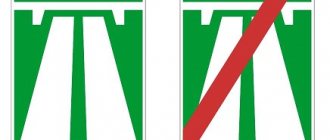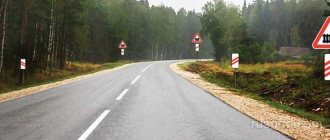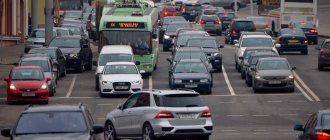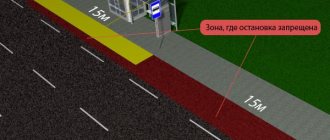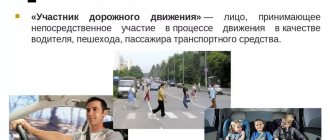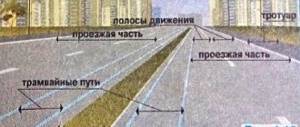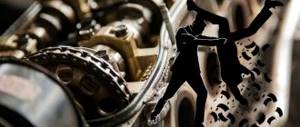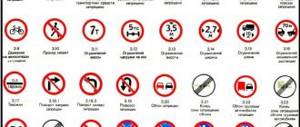Interpretation of clause 8.5 in the traffic rules
Before any turn or U-turn, the driver must change lanes in advance to the outer lane of the road, which is intended for driving in that direction. The exception is when making a circle turn.
When there are tram tracks in the same direction to the left of the car, and they are located level with the road, then such maneuvers should be carried out from them. An exception will be the case when signs numbered 5.15.2 or 5.15.1, as well as road markings 1.18 do not indicate a different order. There should be no interference for the tram during these maneuvers.
In this edition of the Rules, the official text of the paragraph in question has been in effect since 2001. Changes only occurred in 2005 to accommodate the change in sign numbers.
Official interpretation for 2021
8.5. Before turning right, left or making a U-turn, the driver is obliged to take in advance the appropriate extreme position on the roadway intended for traffic in this direction, except in cases where a turn is made when entering an intersection where a roundabout is organized.
If there are tram tracks in the same direction on the left, located at the same level as the roadway, a left turn and a U-turn must be made from them, unless signs 5.15.1 or 5.15.2 or markings 1.18 prescribe a different movement order. This should not interfere with the tram
In this edition, the official text of clause 8.5 has been in effect since 2001. In 2005, the text was changed only to accommodate the change in sign numbers - instead of 5.8.1/2, they were assigned numbers accordingly 5.15.1/2.
Comments to clause 8.5
For drivers, regarding normal turns and U-turns, everything is clear:
- If you intend to turn right, then you need to change into the right lane.
- If a left turn or a U-turn is necessary, then this clause obliges the driver to take the lane as far to the left as possible.
But there are some unclear points at this point. The conversation is about occupying the extreme lane before making a maneuver. But the exact concept of an extreme position is not given . For example, see the diagram below:
Many car owners agree that the green car is in the outer lane to turn right. In other words, the driver did not violate clause 8.5 of the Rules. But this is a relative concept, since there is another clause 9.10 of the traffic rules, which states that the number of driving lanes should be determined depending on the overall dimensions of the car and other vehicles. And this condition slightly contradicts clause 8.5. This is indicated by the lower movement diagram.
As it becomes clear from the figure, the driver of the green car makes a maneuver from the outer lane. But if there is a little space on the right, which is enough for a cyclist, he, in turn, can pass the intersection in the forward direction, which is allowed by the Traffic Rules.
The same situations can be described for left turns or U-turns. It should also be noted that clause 8.5, when turning left or making a U-turn, does not force the driver to be in the left lane at the end of the maneuver. We talk about this only before the turn. But when turning right and there is an opportunity, it is necessary to change into the right lane. This is stated in clause 8.6 of the Traffic Regulations.
Roundabout Circulation
In this case, the conditions of clause 8.5 no longer apply, but the rules of circular motion come into force. The question is that driving in a circle is an exceptional case from paragraph 8.5 of the Rules . A particular problem on Russian roads is that the majority of drivers drive incorrectly at roundabouts and position their cars incorrectly when making maneuvers.
Let us explain in more detail. The official interpretation of the Rules in this matter determines that a circle is a roundabout. This means that while driving along it, the driver must comply with the condition of being in the outer lane. And when leaving it, you need to change gears to it.
Such an action is a movement, so leaving the circle will be a maneuver, and paragraph 8.5 states that the driver should occupy the outer lane when maneuvering. In the Russian Federation, at all such intersections, movement must occur counterclockwise.
Let's explain in detail:
- When the driver enters the circle, he makes a right turn, and paragraph 8.5 of the Rules, as an exception, allows entry from any lane. This has its own logic, since it will not be possible to turn left, because it will be an oncoming lane.
- If the driver intends to leave the roundabout, then this is a right turn, and paragraph 8.5 has an exception only in terms of entering the circle. In this regard, when leaving, you need to change lanes to the right.
This is how you can depict a correct circular motion, indicated by markings:
As shown in the picture above, all vehicles except the red car maneuver correctly. The red car is trying to turn right from the second lane. The green car performs a similar maneuver, but it is allowed to do so with an exception, which is described in clause 8.5 of the traffic rules.
If there are no markings on the circle, then for a red car the violation is not so obvious:
In the top picture there are the same violations with the difference that there are no marking lines. But when the circular motion does not look like a circle, the violation will not be at all obvious.
The positive point is that usually such intersections have the necessary markings. The negative side is that not all circles are equipped with markings, and many drivers still have little knowledge of the traffic rules regarding circular traffic. Because of this, road accidents often occur. Therefore, in this case, an indisputable rule of movement applies - “give way to the fool.”
In addition, you need to take into account that when entering a roundabout, the driver must yield to everyone who is on it. This is stipulated in paragraph 13.11 of the Rules in part 1.
In addition, when driving around a circle, you must turn on the right turn signal twice: once when entering, and once when exiting. There is no need to turn left when driving through a roundabout.
Tram rails
It is also worth considering clause 8.5 of the Rules, which establish the procedure for left turns and U-turns if there are tracks for a tram. Drivers are also not very well versed in them.
However, there is nothing complicated about it:
- If there are road markings or lane signs, then you can only turn from the road, but not from the tram tracks.
- If there are no such signs or markings, then you can only turn from the tram tracks, but you cannot turn from the traffic lane.
In this case, it is not allowed to interfere with the tram. But what should a driver do if he stopped, waiting for a traffic light, and a tram approaches behind him? The Rules don't explain this.
Comments and clarifications to clause 8.5 of the traffic rules
The first paragraph regarding standard turns and U-turns should not cause difficulties for drivers:
- if you are going to turn right, you need to take the extreme position on the right,
- if you need to turn left or make a U-turn, then 8.5 traffic rules instruct you to change lanes to the left as far as possible before the maneuver.
But there is still an understatement in it.
So, we are talking about the obligation to take an extreme position before the corresponding maneuver. At the same time, there is no definition of the extreme position. For example, here is an illustration:
Most car enthusiasts will agree that the driver of the green car took the extreme right position before turning right. That is, I fully complied with the requirements of paragraph 8.5 of the Traffic Regulations of the Russian Federation.
But all this is quite relative! Because there is also paragraph 9.10 of the Rules, which states that the number of rows for traffic is determined taking into account the dimensions of the vehicles. And this to some extent correlates with clause 8.5. This will make it much clearer what we are talking about:
As we can see, although the driver of the green car turns right from the far right lane, if there is still free space on the right, sufficient for someone who (a cyclist) is also going to go through the intersection, and he is allowed to do so according to the traffic rules, then the extreme position is not busy.
The same applies to left turns and U-turns.
Please also note that paragraph 8.5 of the traffic rules in the case of a left turn or U-turn does not oblige the driver to be only in the left lane upon completion of the maneuver - we are talking about taking the extreme position only before the maneuver. But when turning right, if there is an objective opportunity, the driver must stay as far to the right as possible - this is prescribed by the adjacent paragraph 8.6 of the Rules.
Roundabout Circulation
And here the standard action of paragraph 8.5 ends and a special rule for moving in a circle begins. The fact is that roundabouts are an exception to 8.5 traffic rules. And the big problem on Russian roads is that more than half of drivers drive incorrectly at such intersections in terms of position rules when maneuvering.
Let's explain! The official text of the paragraph directly states that a circle is an intersection at which roundabout traffic is organized. This means that while we are moving along such an intersection, we must be guided by the same extreme position, and when leaving the roundabout we need to take the extreme position.
Since this is a movement, it is the exit from the circle that constitutes the maneuver, and 8.5 requires that we take the extreme position during the maneuver. In Russia, at all such intersections, traffic is organized counterclockwise. That is:
- when we enter a roundabout, we turn right, and clause 8.5 of the Russian Traffic Regulations, as an exception, allows us to enter from any lane (or row) - and this is logical, because we cannot turn left on the roundabout, since we will be moving in the opposite direction ,
- if we decide to leave the circle, then this is already a right turn, and 8.5 only excludes entering the circle, so when leaving we need to take the extreme position - right.
This is what a correct circular motion with markings looks like:
As you can see from the illustration above, all drivers except the red car perform the maneuver correctly. The red one turns right from the second lane. Yes, green makes a similar movement, but green is allowed to do this by an exception in paragraph 8.5 of the Rules.
The violation for red is much less obvious if there are no markings on the circle:
In the diagram above there are still the same violations 8.5, the only difference is the absence of lines.
But the violation looks even less obvious when the circle does not resemble itself, like this:
The good news is that most often these intersections have appropriate markings. The bad thing is that on some circles there are no such markings, and most drivers do not know how to drive through a roundabout according to the Rules. As a result, an accident. Therefore, the most important thing here is to include the “give way to a fool” rule.
Please also note that when entering a circle, you are required to give way to everyone who is already on it - 13.11(1) Traffic Regulations. And when passing it, you need to turn on the right turn signals 2 times: when entering the roundabout, and when leaving it. There is no need to turn on the left one when moving along it.
Tram rails
And you should not neglect the second paragraph of clause 8.5 of the Russian Traffic Regulations. It regulates the order of left turns and U-turns in the presence of tram tracks. And this is also the case when many motorists are not aware of the 2021 Rules.
But in fact, everything is quite simple:
- if there are markings and/or signs for moving along lanes, then turning only from the roadway lane, turning from tram tracks 8.5 is prohibited:
- if there are none, then only from tram tracks, it is prohibited to maneuver out of the lane (as the Lada Granta car does in the figure below):
At the same time, in the latter case it is impossible to interfere with the tram. Just what to do if you stood up in this case, waiting for a green traffic light, you’ve been waiting for a minute, when a tram approached from behind, the traffic rules are not explained.
What is the fine?
In this case, the punishment is small, and it is contained in Art. 12.14 of the Administrative Code. There are 2 types of punishment, from which the State Traffic Inspectorate inspector must choose one:
- Warning.
- 500 rubles fine.
If a fine is issued, it can be paid at a reduced cost and a 50% discount, provided that the payment is made no later than 20 days from the date of the decision on the violation. There are no other penalties for this paragraph of the Rules provided by law.
Court practice
In court hearings, different decisions are made regarding violation of the rules of roundabouts and turns:
- The Samara court rejected the complaint of a driver who was punished for making a left turn from the middle lane. The driver decided that the Rules do not prohibit this.
- The Vologda court also did not satisfy the car owner’s complaint and upheld the previous court’s decision that the driver did not take the extreme position when making a right turn, since there were other vehicles in the right lane. One of the cars started moving and a collision occurred.
Traffic rules change periodically, so you need to follow their current text in order to update your knowledge in a timely manner.
